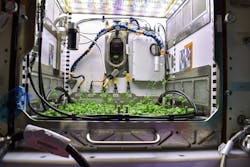Life can be stressful at 260 miles high. But there are ways to cope. For example, plants that grow under LEDs aboard the International Space Station are known to add information to their DNA that helps them to stay calm.
What’s not known, however, is whether plants pass those genetic adaptations on via their seeds, or whether the next generation has to learn how to look after itself all over again.
Cue up the next stage of studies in the ISS’s LED-lit Advanced Plant Habitat chamber.
Earlier this week, an autonomous SpaceX Dragon cargo spacecraft docked to the ISS, and among its payload were the materials that the astronauts will need to raise thale cress to help NASA scientists figure out whether plants do indeed bestow their enhanced DNA upon offspring.
The experiment is called Plant Habitat-03. The objective is to grow thale cress, collect its seeds, and then use those seeds to grow a second generation on the Space Station. Thale cress — part of the mustard family — is formally known as Arabidopsis thaliana and is widely used for plant research.
“Plant Habitat-03 (PH-03) assesses whether plants grown in space can transfer such adaptations to the next generation and, if so, whether a change continues through subsequent generations or stabilizes,” NASA explained in a blog.
For reasons that are not entirely clear, the collected seeds will first return to Earth for processing before heading back to the ISS.
“Seeds produced on orbit are returned to Earth, processed, and used for a second generation of spaceflight growth,” NASA explained on an information page for the Advanced Plant Habitat. “This second ISS grow out, comprising seeds from spaceflight-grown plants together with seeds from terrestrially-grown plants, can help determine whether second generation epigenetic changes continue to accumulate or if they stabilize…
“This investigation can help researchers determine whether growing a generation of plants in space confers an adaptive advantage to the next generation, similar to epigenetic adaptive advantage known to occur with some terrestrial plant stresses.”
While this latest round is not a new development in the LED lighting per se, it is a strong reminder of the importance of LEDs in the horticultural future of humankind, both on Earth and in space.
Commercial horticultural lighting is experiencing a slowdown at the moment but is expected to pick up again when energy prices fall. In the meantime, vendors such as Signify — through both its Fluence and Philips Horticulture LED Solutions divisions — have ratcheted up their efforts to educate growers and the rest of the value chain on the importance of LED lighting for sustainable crops.
The Space Station has itself long harbored many horticultural lighting studies.
ISS orbits at an average of 227 nautical miles, or roughly 260 miles, and is the home to a panoply of scientific experiments.
This week’s cargo drop-off occurred at around 270 miles high, above Brazil. It wasn’t all about botany. The SpaceX Dragon also delivered solar arrays, as well equipment for observing thunderstorms, permafrost thawing in the Canadian Arctic, solar and cosmic radiation effects on geological samples, human chromosome protection, and other processes.
MARK HALPER is a contributing editor for LEDs Magazine, and an energy, technology, and business journalist ([email protected]).
Follow our LinkedIn page for our latest news updates, contributed articles, and commentary, and our Facebook page for events announcements and more. You can also find us on Twitter.






